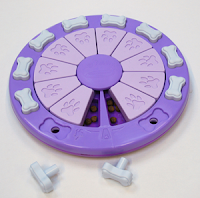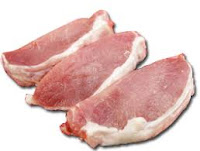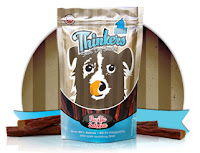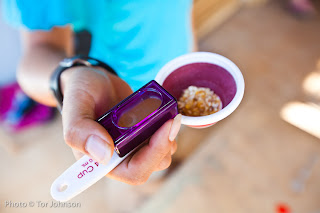Animals in nature spend much of their time hunting and foraging for food. Although pet dogs these days have great lives - they get to live inside the house with their humans, go to dog parks, and get premium vet care - they don't get to use their hunting and problem solving skills as much as they were bred to.
In order to keep dogs from getting bored or destructive (e.g. chewing inappropriate items or digging holes in the yard), you can try giving your dog enrichment food toys, in addition to giving him enough exercise and social interaction.
There's no rule that says a dog needs to eat his meals out of a food bowl. Unless your dog is in the process of getting potty trained, in which case you may want him on a regular feeding schedule, you might consider using his meals for training and enrichment.
In order to keep dogs from getting bored or destructive (e.g. chewing inappropriate items or digging holes in the yard), you can try giving your dog enrichment food toys, in addition to giving him enough exercise and social interaction.
There's no rule that says a dog needs to eat his meals out of a food bowl. Unless your dog is in the process of getting potty trained, in which case you may want him on a regular feeding schedule, you might consider using his meals for training and enrichment.
KONG FOOD TOYS
The Classic Kong (shown left)
This is the most basic model of Kong. It looks like a beehive but it's a thick rubber toy that is hollow in the middle, allowing you to stuff it with food. I recommend mixing dry kibble with a few spoonfuls of canned food (or something else that's wet, like peanut butter) so that the food doesn't come out too easily.
For high drive dogs, you can even freeze the whole thing so that it will take them longer to get the food out.
This is the most basic model of Kong. It looks like a beehive but it's a thick rubber toy that is hollow in the middle, allowing you to stuff it with food. I recommend mixing dry kibble with a few spoonfuls of canned food (or something else that's wet, like peanut butter) so that the food doesn't come out too easily.
For high drive dogs, you can even freeze the whole thing so that it will take them longer to get the food out.
(left) This is an inside view of a Kong stuffed with food.
 Wobbler
Wobbler"The Wobbler is a KONG-shaped food dispensing toy and feeder that sits upright until pushed witha dog's paw or nose, then dispenses treats as it wobbles, spins and rolls. The unpredictable movement keeps the toy challenging, even for seasoned Wobbler users. Use the Wobbler as an alternative to a dog bowl, and help to extend meal time and exercise your dog."
There are other brands that sell similar toys too.

 Kong Dental
Kong Dental"The KONG Dental has special grooves that clean teeth and gums as dogs chew. KONG Easy Treat can be used inside the grooves to get your dog chewing."
Like the Kong Classic, it is hollow inside so that you can stuff it with food.
NINA OTTOSON DOG ACTIVITY TOYS
Website: http://www.nina-ottosson.com/Dog-2.php
Available through Amazon.com or Nina's website
Nina Ottoson has a large selection of dog food toys that vary in difficulty level. If the Kong is too easy for your smart dog, then you might consider these toys. The purple toy on the right is called a DogTwister - the dog has to move the little pieces around in order to access the food. The blue one is called a DogTornado - the dog has to spin the compartments around and remove the little white lids to get to the food.
You can see the DogTwister on YouTube at:
http://www.youtube.com/watch?v=bG4xWycW3GQ&feature=youtu.be
PREMIER'S BUSY BUDDY SERIES
Kibble Nibble (similar to Kong's Wobbler) - this toy is egg-shaped and dispenses kibble or treats through a small hole as the dog rolls it around.
Twist N Treat
The Twist N Treat is a fun toy in which you can put various size treats. You can adjust the difficulty level of the toy by twisting the top and modifying the size of the opening on the side.
The Twist N Treat is a fun toy in which you can put various size treats. You can adjust the difficulty level of the toy by twisting the top and modifying the size of the opening on the side.
Chuckle
Either end of the Chuckle has inner-facing, soft, adjustable rubber prongs that move aside to allow the toy to be stuffed with kibble or treats. The prongs of the Treat Meter™ allow food and treats to randomly dispense, rewarding your dog as he plays. Made of natural rubber. There's another similar product called Waggle, also by Premier.
Either end of the Chuckle has inner-facing, soft, adjustable rubber prongs that move aside to allow the toy to be stuffed with kibble or treats. The prongs of the Treat Meter™ allow food and treats to randomly dispense, rewarding your dog as he plays. Made of natural rubber. There's another similar product called Waggle, also by Premier.
AIKIOU DOG FEEDER
Website: http://www.aikiou.com/
Food is hidden inside this feeder’s many compartments, which your dog can access by sliding the doors open or spinng the central wheel. Allowing your dog to exercise his or her problem solving instincts with the Aikiou bowl fun and rewarding for you and your pet while keeping him fit by reducing his speed of ingestion.
Watch the YouTube video below to see some dogs eating out of an Aikiou:
http://www.youtube.com/watch?v=YaSvx1264qM
*****************************************************************
For ideas on what kinds of treats to put in the above food toys, see my last blog "Training Treats - A Biscuit Ain't Gonna Cut It".
*****************************************************************
DEER ANTLERS
Website: http://www.qtdog.com/antlerz.htm
These 100% naturally shed deer antlers are cleaned and packaged for the chewing pleasure of your dog! These natural dog chews will not splinter or chip making them a safe treat for even the most aggressive chewers. Not only will they satisfy your dogs need to gnaw but they will provide nutrition because they are naturally rich in minerals such as calcium and phosphorus. The only caveat with deer antlers is that they are very hard, so I've heard from a few dog owners that their dogs chipped a tooth. So this might be best for mild chewers rather than hardcore chewers, and better for adult dogs than puppies.
Available at Crazy Canine pet store in Aiea
RAW BEEF BONES
Primal brand raw beef marrow bones (right) available at Crazy Canine pet store in Aiea
Raw beef hooves (below) available at Tamura's grocery store (and probably meat departments of most grocery stores)
A raw beef bone or hoof is another good option for keeping your dog occupied. Raw bones are good for the dogs' teeth, and are safer than cooked or smoked bones because they don't crack. As gross as it might seem to a human, I have yet to meet a dog that doesn't love raw beef bones! (Important Note: You should throw the bone away after 1 day, as the bone may accumulate bacteria and/or dry out and crack, which is dangerous for your dog.)
FROZEN WATER and CHICKEN BROTH WITH TOYS 'N TREATS!
Freeze water and chicken broth with toys, carrots, treats, etc to keep dogs from getting bored and overheated in the backyard.
COCONUT HUSK
Coconuts are everywhere in Hawaii. This is an inexpensive and eco-friendly chew toy for those who don't want to bother with fancy toys. You can even add a little flavor to the coconut husk by pouring some chicken broth or meat-based sauce on it.
Website: http://www.aikiou.com/
Food is hidden inside this feeder’s many compartments, which your dog can access by sliding the doors open or spinng the central wheel. Allowing your dog to exercise his or her problem solving instincts with the Aikiou bowl fun and rewarding for you and your pet while keeping him fit by reducing his speed of ingestion.
Watch the YouTube video below to see some dogs eating out of an Aikiou:
http://www.youtube.com/watch?v=YaSvx1264qM
*****************************************************************
For ideas on what kinds of treats to put in the above food toys, see my last blog "Training Treats - A Biscuit Ain't Gonna Cut It".
*****************************************************************
DEER ANTLERS
Website: http://www.qtdog.com/antlerz.htm
These 100% naturally shed deer antlers are cleaned and packaged for the chewing pleasure of your dog! These natural dog chews will not splinter or chip making them a safe treat for even the most aggressive chewers. Not only will they satisfy your dogs need to gnaw but they will provide nutrition because they are naturally rich in minerals such as calcium and phosphorus. The only caveat with deer antlers is that they are very hard, so I've heard from a few dog owners that their dogs chipped a tooth. So this might be best for mild chewers rather than hardcore chewers, and better for adult dogs than puppies.
Available at Crazy Canine pet store in Aiea
RAW BEEF BONES
Primal brand raw beef marrow bones (right) available at Crazy Canine pet store in Aiea
Raw beef hooves (below) available at Tamura's grocery store (and probably meat departments of most grocery stores)
A raw beef bone or hoof is another good option for keeping your dog occupied. Raw bones are good for the dogs' teeth, and are safer than cooked or smoked bones because they don't crack. As gross as it might seem to a human, I have yet to meet a dog that doesn't love raw beef bones! (Important Note: You should throw the bone away after 1 day, as the bone may accumulate bacteria and/or dry out and crack, which is dangerous for your dog.)
FROZEN WATER and CHICKEN BROTH WITH TOYS 'N TREATS!
Freeze water and chicken broth with toys, carrots, treats, etc to keep dogs from getting bored and overheated in the backyard.
COCONUT HUSK
Coconuts are everywhere in Hawaii. This is an inexpensive and eco-friendly chew toy for those who don't want to bother with fancy toys. You can even add a little flavor to the coconut husk by pouring some chicken broth or meat-based sauce on it.
























